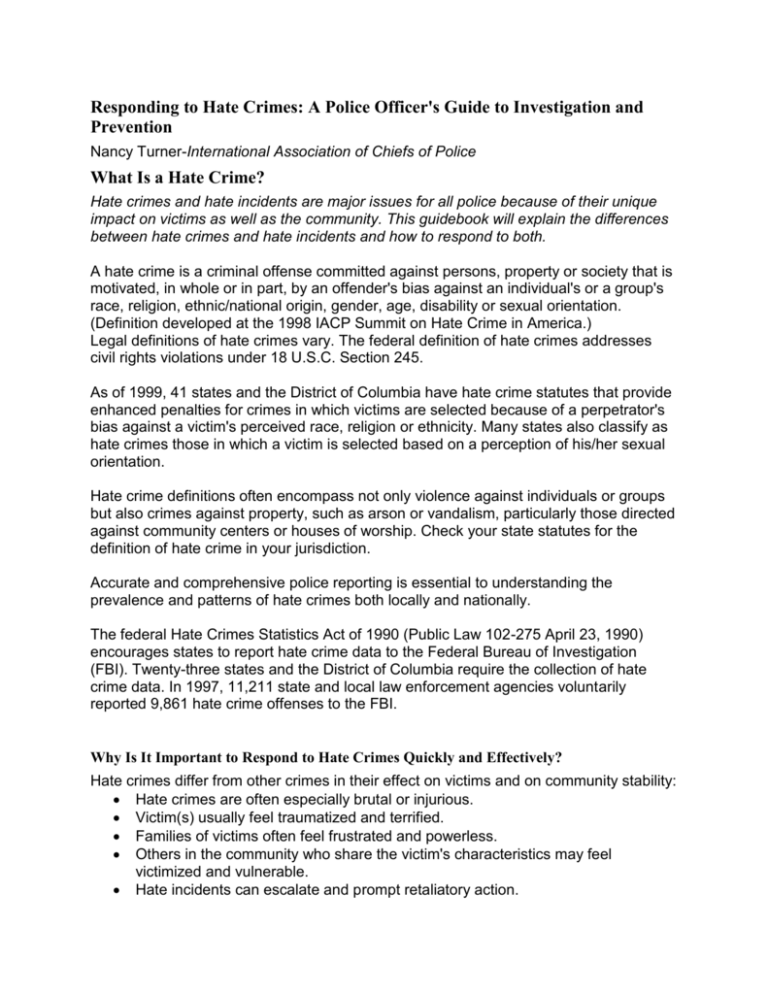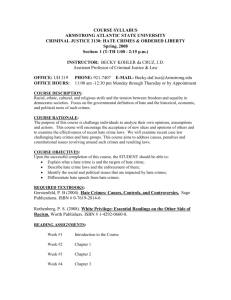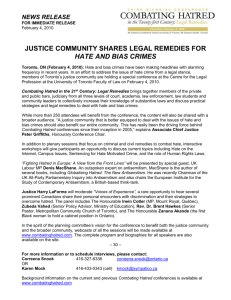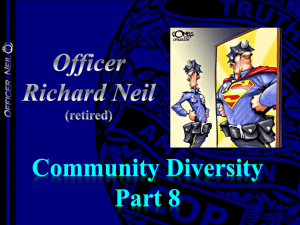Responding to Hate Crimes: A Police Officer's Guide to Investigation
advertisement

Responding to Hate Crimes: A Police Officer's Guide to Investigation and Prevention Nancy Turner-International Association of Chiefs of Police What Is a Hate Crime? Hate crimes and hate incidents are major issues for all police because of their unique impact on victims as well as the community. This guidebook will explain the differences between hate crimes and hate incidents and how to respond to both. A hate crime is a criminal offense committed against persons, property or society that is motivated, in whole or in part, by an offender's bias against an individual's or a group's race, religion, ethnic/national origin, gender, age, disability or sexual orientation. (Definition developed at the 1998 IACP Summit on Hate Crime in America.) Legal definitions of hate crimes vary. The federal definition of hate crimes addresses civil rights violations under 18 U.S.C. Section 245. As of 1999, 41 states and the District of Columbia have hate crime statutes that provide enhanced penalties for crimes in which victims are selected because of a perpetrator's bias against a victim's perceived race, religion or ethnicity. Many states also classify as hate crimes those in which a victim is selected based on a perception of his/her sexual orientation. Hate crime definitions often encompass not only violence against individuals or groups but also crimes against property, such as arson or vandalism, particularly those directed against community centers or houses of worship. Check your state statutes for the definition of hate crime in your jurisdiction. Accurate and comprehensive police reporting is essential to understanding the prevalence and patterns of hate crimes both locally and nationally. The federal Hate Crimes Statistics Act of 1990 (Public Law 102-275 April 23, 1990) encourages states to report hate crime data to the Federal Bureau of Investigation (FBI). Twenty-three states and the District of Columbia require the collection of hate crime data. In 1997, 11,211 state and local law enforcement agencies voluntarily reported 9,861 hate crime offenses to the FBI. Why Is It Important to Respond to Hate Crimes Quickly and Effectively? Hate crimes differ from other crimes in their effect on victims and on community stability: Hate crimes are often especially brutal or injurious. Victim(s) usually feel traumatized and terrified. Families of victims often feel frustrated and powerless. Others in the community who share the victim's characteristics may feel victimized and vulnerable. Hate incidents can escalate and prompt retaliatory action. Hate crimes and hate incidents create communitywide unrest. A swift and strong response by law enforcement can help stabilize and calm the community as well as aid in a victim's recovery. Failure to respond to hate crimes within departmental guidelines may jeopardize public safety and leave officers and departments open to increased scrutiny and possible liability. What Is the Difference Between a Hate Incident and a Hate Crime? Hate incidents involve behaviors that, though motivated by bias against a victim's race, religion, ethnic/national origin, gender, age, disability or sexual orientation, are not criminal acts. Hostile or hateful speech, or other disrespectful/discriminatory behavior may be motivated by bias but is not illegal. They become crimes only when they directly incite perpetrators to commit violence against persons or property, or if they place a potential victim in reasonable fear of physical injury. Officers should thoroughly document evidence in all bias-motivated incidents. Law enforcement can help to defuse potentially dangerous situations and prevent bias-motivated criminal behavior by responding to and documenting bias-motivated speech or behavior even if it does not rise to the level of a criminal offense. What Is an Effective Police Response to Hate Crimes? Police officers and investigators have important roles to play in responding to hate incidents and crimes. By doing the job efficiently and carefully, police can reinforce the message that hate crimes will be investigated aggressively, thus enhancing the likelihood of a successful prosecution. Police Officers Arriving on the Scene Should Act Immediately to secure the scene stabilize the victim(s) and request medical attention when necessary ensure the safety of victims, witnesses and perpetrators preserve the crime scene; collect and photograph physical evidence such as hate literature spray paint cans threatening letters symbolic objects used by hate groups (e.g., swastikas, crosses) identify criminal evidence on the victim request the assistance of translators when needed conduct a preliminary investigation; record information on identity of suspected perpetrators(s) identity of witnesses, including those no longer on the scene prior occurrences, in this area or with this victim statements made by suspects--exact working is critical arrest the perpetrator(s) if probable cause exists Note: In the presence of the victim, the officer should neither confirm nor deny that the incident is a hate crime--that determination will be made later in the investigative process. After taking immediate action, police officers should assign only one officer to interview the victim(s) whenever practical in order to minimize trauma protect the anonymity of victim whenever possible explain to victim and witnesses the likely sequence of events, including contact with investigators and the possibility of media coverage refer victim to support services in the community; provide written resource lists when possible tell victim how to contact the police department to obtain further information on the case report the suspected hate crime to the supervisor on duty refer media representatives to the supervisor on duty or public information officer document the incident thoroughly on department report forms, noting any particular hate crime indicators and quoting exact wording of statements made by perpetrators assist investigators in making any other reports that may be required under federal or state guidelines and laws When conducting a thorough follow-up investigation, officers should interview victims(s) and witnesses thoroughly and respectfully secure evidence by taking photos of offensive graffiti or other symbols of bias document the circumstances and apparent motives surrounding the event locate and arrest any suspected perpetrators not apprehended at the scene provide their supervisor or public information officer with information that can be responsibly reported to the media inform victim of what is likely to happen during the continuing investigation appeal to witnesses to come forward by canvassing the community offer rewards for information about the incident when possible coordinate with other law enforcement agencies in the area to assess patterns of hate crimes and determine if organized hate groups are involved collaborate with the responding officers to complete any written reports required by their department, state and federal agencies notify the FBI if further assistance with investigations is needed What Are the Key Indicators that a Hate Crime May Have Been Committed? The main difference between a hate crime and other crimes is that a perpetrator of a hate crime is motivated by bias. To evaluate a perpetrator's motives, you should consider several bias indicators: perceptions of the victim(s) and witnesses about the crime the perpetrator's comments, gestures or written statements that reflect bias, including graffiti or other symbols any differences between perpetrator and victim, whether actual or perceived by the perpetrator similar incidents in the same location or neighborhood to determine whether a pattern exists whether the victim was engaged in activities promoting his/her group or community--for example, by clothing or conduct whether the incident coincided with a holiday or data of particular significance involvement of organized hate groups or their members absence of any other motive such as economic gain The presence of any of these factors does not confirm that the incident was a hate offense but may indicate the need for further investigation into motive. A victim's perception is an important factor to consider, but be aware that victims may not recognize the crime as motivated by bias. Victims should not be asked directly whether they believe they were the victim of a hate crime, but it is appropriate to ask if they have any idea why they might have been victimized. Victims and perpetrators may appear to be from the same race, ethnicity/nationality, or religion, but it is the perpetrator's perception of difference (whether accurate or not) motivating his or her criminal behavior that would constitute a hate crime. What Are the Best Approaches for Working with Victims of Hate Crime? Hate crimes are unique. Victims of hate crimes are targeted because of a core characteristic of their identity. These attributes cannot be changed. Victims often feel degraded, frightened, vulnerable and suspicious. This may be one of the most traumatic experiences of the lives. Community members who share with victims the characteristics that made them targets of hate (race, religion, ethnic/national origin, gender, age, disability or sexual orientation) may also feel vulnerable, fearful and powerless. In this emotional atmosphere, law enforcement officers and investigators must attend carefully to the ways they interact and communicate with victims, their families and members of the community. Effective Ways for Police to Support Victims While Investigating the Crime remain calm, objective and professional ask victim(s) how they want you to help them request the assistance of translators when needed let victim defer answering questions if they are too distraught ask them they have any idea why this happened to them reassure victim that they are not to blame for what happened voice you support of the actions the victim took to protect themselves and defuse the situation allow them to vent feelings about the incident or crime encourage victim to tell the story in their own words ask them to recall, the best of their ability, the exact words of the perpetrator(s) ask victim if they have family members or friends who can support them inform them of what efforts can be made to enhance their safety reassure them that every effort will be made to protect their anonymity during the investigation tell victim about the probable sequence of events in the investigation provide information about community and department resources available to protect and support victim, their families and members of the community Avoid: being abrupt or rushed tell victim(s) that you know how they feel asking them whether they think this was a bias or hate crime criticizing the victim's behavior making assumptions about the victim's culture, religion, sexual orientation or lifestyle choices allowing personal value judgements about the victim's behavior, lifestyle or culture to affect your objectivity using stereotyped or biased terms belittling the seriousness of the incident, especially if the perpetrator was a juvenile Reasons Why Victims May Be Reluctant to Report or Participate in the Investigation of a Hate Crime: fear of re-victimization or retaliation fear of having privacy compromised for gays and lesbians, fear of repercussions from being "outted" to family and employers fear of law enforcement and uncertainty about justice agency responses for aliens, fear of jeopardizing immigration status, being reported to INS or deportation humiliation or shame about being victimized lack of a support system cultural and language barriers What Is the Ongoing Role the Police Play with Hate Crime Victims and the Community? By providing a continuing point of contact throughout the investigation and prosecution phase, police can facilitate a victim's cooperation with the justice system, assist with the healing process and promote law enforcement's credibility. In the following ways, officers and their departments can support hate crime victims and members of the community: Provide victim(s) a point of contact in the department to whom they can direct questions or concerns. Inform them on case progress including the end result of the investigation and/or prosecution Help to connect them with appropriate support services, victim advocates and community-based organizations when needed Protect the privacy of victim and their families as possible Engage the media as partners in restoring victimized communities through sensitive and accurate reporting Support or coordinate community clean-up efforts Participate in meetings or other forums designed to address the community wide impact of hate incidents or crimes Share information, as appropriate, with schools about cases where students or staff were victims or perpetrators of hate crimes Collaborate with community leaders to mobilize resources that can be used to assist victims and prevent future hate incidents and crimes Police Officers and Their Agencies Can Assume a Leadership Role in Their Community to Prevent Hate Incidents and Crimes Police officers can ... Help to ensure that victims of hate crimes will report their victimization by demonstrating that law enforcement will respond swiftly and compassionately to all reports Participate in hate crime training Serve as positive role models, exemplifying tolerance of and respect for others Maximize cultural awareness to better communicate and work with citizens from diverse ethnic, racial and religious backgrounds Collaborate with community leaders to increase tolerance and promote peaceful conflict resolution among community members Support and participate in school programs and curricula intended to reduce prejudice and prevent bias-motivated crimes Work with citizens and community organizations to identify and address bias incidents and make referrals to state and local agencies (housing, employment and civil rights) to resolve problems Encourage the media to highlight community successes in preventing and responding to hate crimes and incidents Contribute to tracking and monitoring organize hate groups by gathering, documenting and reporting information about their criminal activities in affected communities Police agencies can ... Establish a policy of "zero tolerance" for prejudice throughout the department Ensure police are trained to recognize and respond appropriately to hate crimes Provide officers with user-friendly hate crime incident report forms that comply with state and national reporting standards Sponsor and participate in community events and activities that promote diversity, tolerance, bias reduction and conflict resolution Track the criminal activities of organized hate groups Collaborate with community organizations, schools, and other public agencies to develop coordinated approaches to hate crime prevention and response Engage the media as partners in restoring victimized communities and preventing bias-motivated incidents and crimes Document the positive outcomes of hate crime prevention and response strategies Police officers and their agencies can accomplish much by working in partnership with citizens to implement the American vision of diverse and tolerant communities that offer freedom, safety and dignity for all. This project was supported by a grant award #1999-DD-BX-0071 from the Bureau of Justice Assistance and the Office for Victims of Crime; Office of Justice Programs; U.S. Department of Justice, to the International Association of Chiefs of Police. For more information, please contact: Nancy Turner; (703) 836-6767








